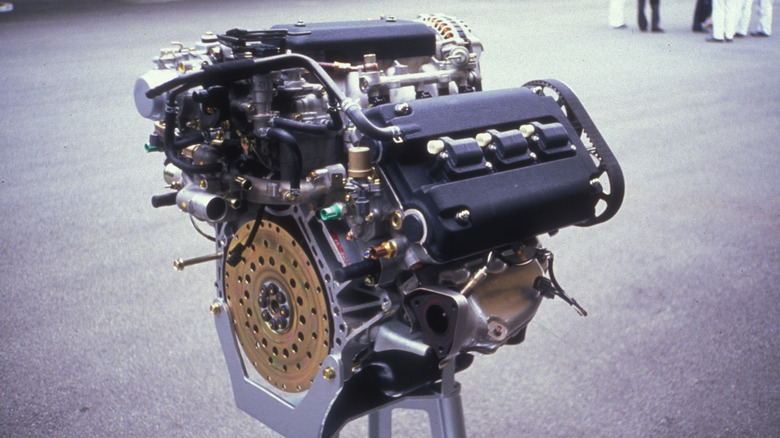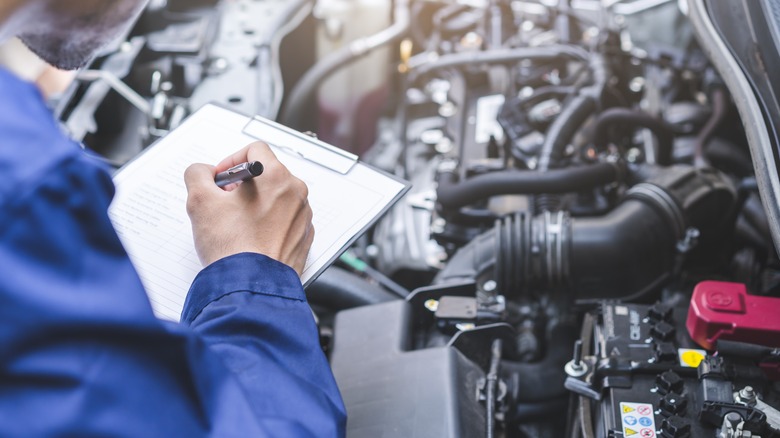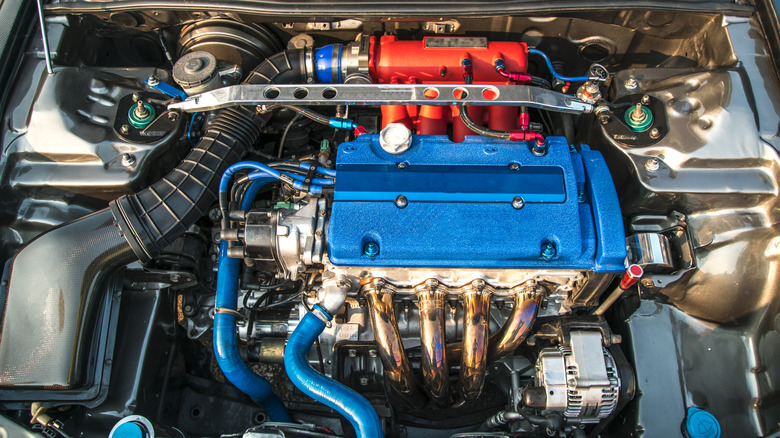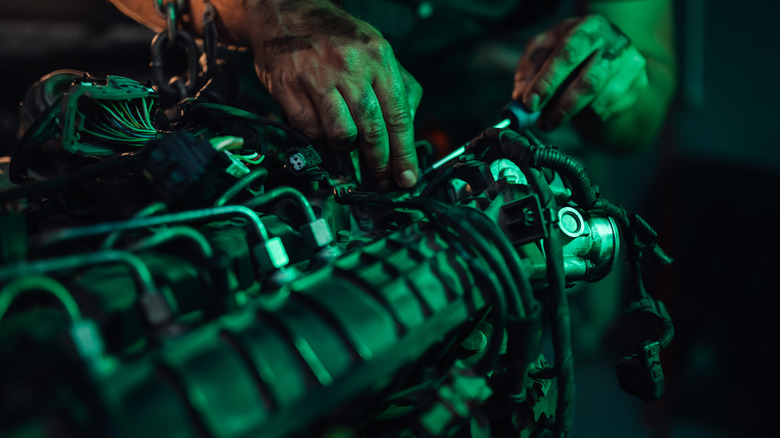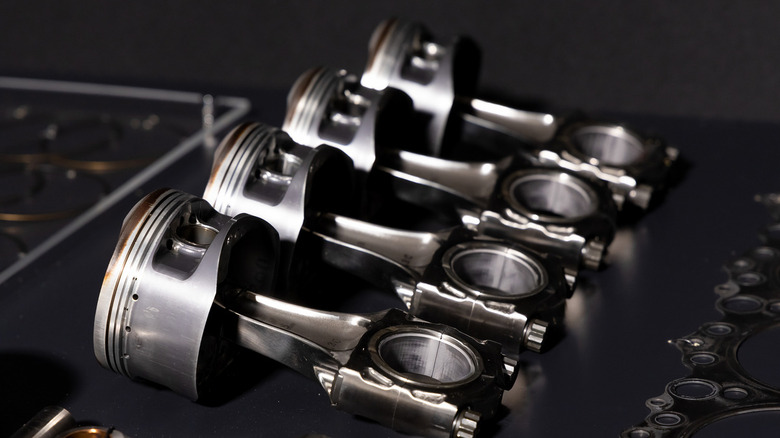5 Tips To Know Before Buying A Used JDM Engine
Swapping out the old, tired, or broken engine in your car can be useful if you're looking to keep a classic car running or if you're looking for more power. And for a long time in the Japanese car-enthusiast community, owners and builders have been buying engines from Japan and swapping them into their American cars. JDM (Japanese Domestic Motor) engines are often stacked high in warehouses, offering relatively affordable, and potentially reliable power that can directly replace their tired motor with minimal modifications. I should know — I've swapped out the engine in my old import several times, using various used JDM engines, with relative ease.
I've spent the majority of my adult life around cars, and like all wrenching enthusiasts, a lot of that time has been spent under the hood of cars, swapping parts, fixing leaks, or otherwise doing some sort of maintenance. I have also spent a considerable amount of time swapping engines in and out of my personal cars and helping friends do the same. Plus, seen people pour money down the drain on hopeless non-working engines, and I've bought entire junkyard cars just to salvage the engine, with mixed results. But I've also seen a few excellent choices in regards to engine swaps. Those experiences have taught me some helpful lessons when picking an engine, learning which engines will cause you headaches, and which ones to avoid entirely.
An engine without a warranty
Because of Japanese inspection programs called Shaken, many low-mile vehicles are often taken off the road in Japan, with their engines eventually destined for other markets. That's the source of many JDM engines making their way to the United States, so the engine's miles are low enough that a shop can sometimes guarantee its running and driving condition. And if a warranty is important on a brand-new car, imagine how useful it could be on something used and un-tested. Many engine shops or large engine warehouses will provide at least some kind of start-up or 30-day warranty to go with your swap, giving you time to properly install the engine after you buy it and make sure it runs. This is great, because this is what you want.
In your search for a JDM engine, it's an excellent strategy to look for shops that have warranties, especially if the engines that they're selling weren't pulled from running, driving cars. Sometimes, these warranties will require having the engine work/install done by a reputable mechanic, or they'll have special provisions. Modifying the engine, taking it apart and installing performance upgrades, or waiting too long to install it could void the warranty, so be sure to check the fine print. There are lots of ways to make sure the used engine you're buying is good, but a warranty will protect you just in case it isn't.
An engine that doesn't pass inspection
Some buyers and builders are comfortable buying used engines on the internet, without seeing them in person first. I'm not one of those buyers. I want to see an engine in person and be able to check it visually. On top of visually inspecting the engine for cracks, holes, or other exterior physical damage, most used engines will still have their old spark plugs installed, so you can check their condition. If you're lucky, you can also check the oil (if it hasn't been drained) for signs of internal engine damage. These are the first steps in my inspections, and critical if you're buying a used JDM engine from a junkyard, but if possible I also like to test an engine for compression.
More than just a good practice for JDM engines, finding an engine that can be tested for compression is a good practice for any used engine. Compression testing can reveal internal engine problems that a visual inspection won't. The easiest way to compression-test an engine is with the engine installed in a running car. A compression test can be done outside the car, but it's harder and requires some extra tools and parts. Granted, compression testing isn't a deal-breaker for me before buying an engine, but it's one of the first things I'd do once an engine was installed.
An engine that's illegal in your state
Car regulations vary from state to state. JDM engine swaps are legal in some places, illegal in others, so we definitely recommend researching whether the specific JDM engine you plan on installing is legal to use where you live. Some engines that may cause you specific problems include engines that are older than the car you're swapping them into, or engines that were never used in American cars, but emissions testing can also be a concern (especially in places like California). Just because an engine is one of the best you can get for your project car, doesn't mean it's legal.
In the Japanese car community, there are dozens of forums that can help guide you towards the right engine for your swap, specifically one that's legal where you live. Lean on those resources, but always be sure to check the letter of the law before you start swiping your credit card on a used motor. It's also worth noting that engines from other markets may require some modification to fit in your engine bay, even if the car is the same make and model. Electronics often aren't a perfect match, so you'll need to make sure that's sorted out as well.
Seized engines of any type
While there might be some rare engines that are worth the time and money to repair, I've found that seized engines are generally more trouble than they're worth. Seized engines (or locked-up/frozen engines) won't turn over, and you'll need to do some serious work before they'll fire up. Thankfully, you don't have to install them in your car to check if an engine is seized — they won't turn over on a static display, either.
Removing the drive belt and using a breaker bar on the crankshaft pulley can help you determine whether the engine is seized or not. Seized engines aren't always completely useless — they can sometimes serve as donors for spare parts, or with enough work they can be brought back to life. This kind of work, however, is pretty difficult and somewhat specialized depending on the engine. If an engine doesn't come with a warranty, it's particularly important to check whether or not it's seized.
Mismatched engines
Getting a complete engine is always your best bet on the used market. Having to trace the history of an engine through several rounds of modification or repair, though, can be dicey at best. For instance, if you find a used engine with a block that doesn't match the head, or pistons that have been replaced for no good reason, I'd recommend heading quickly in the opposite direction. This is especially true if the original parts are nowhere to be found or not included in the sale.
Generally, this kind of scenario pops up when you're buying an engine from a single person rather than a large company or engine retailer. Finding a used JDM engine from a solo seller on the internet can be appealing, but mismatched parts are often a sign of previous modifications gone wrong. The more mismatched an engine is, the more likely it is to have been repaired or upgraded with substandard parts. Or, it could be the reason the seller is getting rid of the engine — the parts they've installed might not work properly — so tread carefully if all the major engine components aren't from the same engine.
